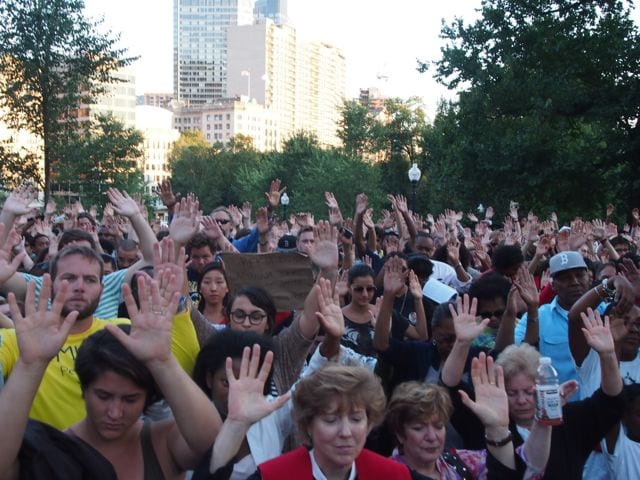Social media drives news coverage of Ferguson shooting, protests
Images posted on social media by protestors counters narratives by police, corporate media

Social media has played a major role in news coverage of the police shooting of Michael Brown in Feguson, Mo., providing a forum for the black community there and across the U.S. to counter the narratives playing in the white-dominated corporate media.
Black commentators tied Brown’s shooting to dozens of instances of police shootings of unarmed black men (and women), highlighting disparate treatment of blacks by news media.
In the initial coverage of Brown’s shooting, some media outlets ran photos of the teenager smiling in his high school graduation cap and gown. But most news media chose to run a photo of Brown frowning, wearing a red Nike tank top and flashing a peace sign. The media bias against the graduation photo led to a twitter campaign, #iftheygunnedmedown in which black men posted photos of themselves in hooded sweatshirts and in business attire and questioned which image the news media would use if they were killed.
The discussion of how the corporate media portrays black police shooting victims heated up when Ferguson Police Chief Thomas Jackson seemed to play into a black victim-as-perpetrator narrative, releasing footage from a security camera showing a black male they said was Michael Brown allegedly stealing cigars from a convenience store.
The police later admitted that Brown was not suspected of that crime when he was shot by white officer Darren Wilson.
Some of the more powerful images coming out of news coverage and social media posts from Ferguson showed police officers clad in military garb, perched on top of armored vehicles and training high-powered assault rifles on protesters and bystanders in the predominantly black Ferguson neighborhood where Brown was gunned down. Those images went viral, sparking media scrutiny the use of military equipment by local police departments.
The police officers’ aggressive use of tear gas and rubber bullets garnered international media attention, and solidarity from Palestinians in Gaza who took to twitter to express solidarity and advise Ferguson residents how to cope with tear gas. “Remember not to touch your face when teargassed or put water on it. Use milk or coke!” offers Mariam Bargouthi.
There was also a good deal of news analysis of the conditions in Ferguson, a predominately black suburb of St. Louis where just 3 of the the 53 officers on the police force are white. Blacks are also vastly underrepresented in the town’s city government, according to a report on MSNBC.
Finally, protesters in cities around the world and as far away as Melbourne, Australia posted photographs of the solidarity rallies against police brutality on social media. Many images posted showed demonstrators holding their hands up, the stance eyewitnesses said Brown assumed before he was gunned down by Wilson.







